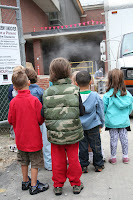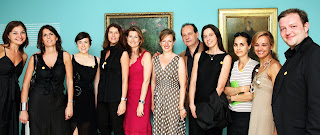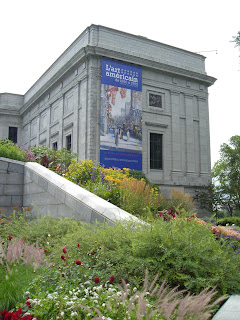Click here to read Part I of The Museum Project on Blog Addison.
The students have been exploring ideas about collections and museums for the last few months, working with their families to document their own collections at home, presenting their documentation in class, reading book after book about collecting, art, artists, and museums, and documenting a visit to a museum of their choice with their families. Their incredible teachers have infused these ideas into everything they do in the classroom, from studying collections of primary and secondary colors to making collections of vocabulary words to learning about collections of books at the local library.
 On December 4th, 2009, seventeen Kindergarten Prep students, twelve parents, two teachers, and the Addison’s museum educators boarded a bus to the Peabody Essex Museum (PEM) in Salem to explore the museum as a group and put inspiration to use in creative ways.
On December 4th, 2009, seventeen Kindergarten Prep students, twelve parents, two teachers, and the Addison’s museum educators boarded a bus to the Peabody Essex Museum (PEM) in Salem to explore the museum as a group and put inspiration to use in creative ways.In the Trash Menagerie exhibition, which presents over thirty works of art created from things most of us simply throw away, PEM’s School and Teacher Program Manager (and former Addison Education Fellow) Rebecca Hayes helped students exercise their observation and interpretation skills, consider the function and use of everyday objects, and see what incredible things can be made from recyclables.
 Rebecca: What is this sculpture of a moth made of?
Rebecca: What is this sculpture of a moth made of?Students responses: Trash, a plate, a broken plate, a pot, wood (It’s from a piano! I can tell because it’s white and brown.), little wires, elastic…
(Image credit: Michelle Stitzlein, Sulphur Blue Smeck, 2005, Moth Series, piano keys, roofing metal, light fixtures, bicycle fenders and fork, china, electrical wire, lawn mower handles, and other trash, Peabody Essex Museum, Salem.)
A discussion about the moth’s antennae being made from bike handles led to a conversation about what you could create from an old bicycle, which then led to brainstorming about creating art.
Rebecca: What could we use at home to make art? What do we recycle?
- I make airplanes out of old writing.
- Juice boxes! I’m going to make a school bus!
 In the adjacent art studio, students used this inspiration to cut, rip, glue, and color empty cereal boxes, egg cartons, shampoo bottles, string, and paper strips into their own art menagerie.
In the adjacent art studio, students used this inspiration to cut, rip, glue, and color empty cereal boxes, egg cartons, shampoo bottles, string, and paper strips into their own art menagerie.- A flower! Now it’s a snowflake.
- A sketch of lightning. I cut one half and now I have to cut the other half.
- A spider. We’re making it together so we can make a big one.
 Students also had the opportunity to meet PEM security guard Peter, who fielded a wide range of questions, including:
Students also had the opportunity to meet PEM security guard Peter, who fielded a wide range of questions, including:- Why do you have badges?
- Do you work all night?
- So why do we have museums, anyway?
Peter, an artist himself, was quite stunned when the students said that they had been studying the work of Robert Rauschenberg – along with Pablo Picasso and Claude Monet.
These profound connections between objects in the museum and in home collections, between topics in the museum and classroom curriculum studied, and between art and ideas will push students’ curiosity immeasurably further in the coming weeks.
Stay turned for further updates as this project progresses.
Posted by
Jamie Kaplowitz
Education Fellow













 Two of our Winslow Homers,
Two of our Winslow Homers,  And, while you are at the Met, stop in at the
And, while you are at the Met, stop in at the 
 The Kindergarten Prep class started off their year with an exploration of trucks and construction. After reading books about construction and exploring photographs of the Addison’s construction site, it was time to kick off our Museum Project by visiting the Addison’s museum-in-progress. On a Friday morning in September, we ventured with Kindergarten Prep students, teachers, and parents to the
The Kindergarten Prep class started off their year with an exploration of trucks and construction. After reading books about construction and exploring photographs of the Addison’s construction site, it was time to kick off our Museum Project by visiting the Addison’s museum-in-progress. On a Friday morning in September, we ventured with Kindergarten Prep students, teachers, and parents to the  We stood in the Addison driveway watching the workers create clouds of billowing dust from sawing new counter tops. We peered through the green fencing along the front of the museum and discussed why it was there. The students noticed that if you stood far enough back, you could see more than you could when you’re standing close, so we experimented with the views from different distances. We discussed the building materials we could see and how the newly constructed metal and glass section compares to the original brick building.
We stood in the Addison driveway watching the workers create clouds of billowing dust from sawing new counter tops. We peered through the green fencing along the front of the museum and discussed why it was there. The students noticed that if you stood far enough back, you could see more than you could when you’re standing close, so we experimented with the views from different distances. We discussed the building materials we could see and how the newly constructed metal and glass section compares to the original brick building. Back in the classroom, the students have turned their block area and their sand table into construction zones, complete with a fence to keep everyone safe! They will soon be sharing their own collections from home that they are documenting with their parents.
Back in the classroom, the students have turned their block area and their sand table into construction zones, complete with a fence to keep everyone safe! They will soon be sharing their own collections from home that they are documenting with their parents.




























